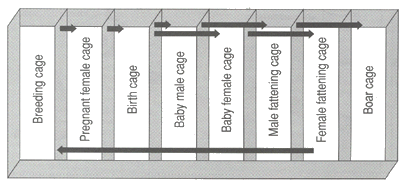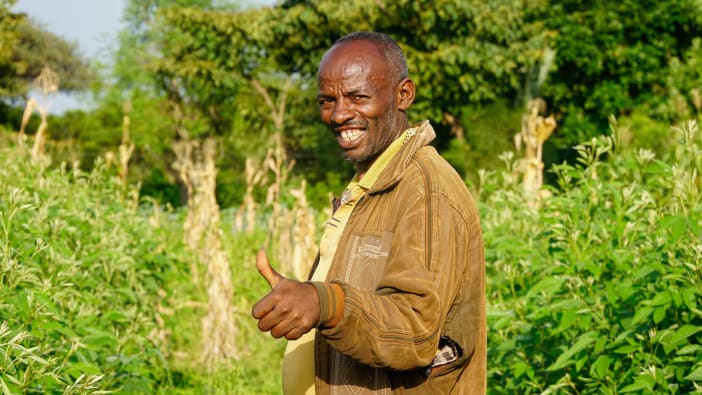The guinea pig or cavy (cuy or cobayo) comes from the Andes in South America. Villagers in many parts of South America keep guinea pigs in their kitchens.
Guinea pigs have many good points:
- They are small animals that are herbivorous (live only on vegetables and green leaves).
- They are easy to raise
- They are timid and do not try to run off.
- The meat is tasty and high in protein.
- Because of their size (usually 0.5-1.5kgs) they can easily be eaten by a family in one meal.
- The fur is very good and can often be sold.
In the Andes, guinea pig is often served as a favourite dish. In Peru alone there are 22 million of them. They are also eaten by the highland people of Bolivia, Colombia and Ecuador. Most people who raise guinea pigs do so for their own household consumption, or to exchange for other food, such as rice.
Researchers in Ecuador and Peru have been working on developing much larger breeds of guinea pigs which grow rapidly. These breeds are being slowly distributed in parts of South America. If you would like to obtain a large, improved male, try asking your agricultural extension officer for advice about where you could get one, or write to: Heifer Project, PO Box 808, Little Rock, AR 72203, USA for advice about a local source.
Traditional production
Many people allow guinea pigs to run freely around the cooking hut. Small pens may be built of adobe (mud) bricks, often underneath the cooking stove, since guinea pigs like to keep warm. This system has some advantages:
- Guinea pigs do not climb so they are easy to keep in such pens.
- This system protects them from dogs, rats, foxes and cats which will all eat guinea pigs.
But there are also some disadvantages:
- Breeding cannot be planned and so the production of guinea pigs for meat will not be very high.
- Disease can also be a problem as such pens are not easy to clean.
- Pregnant guinea pigs are often picked for cooking because of their large size.
This simple system is used by many folk in the Andes. Production could be increased by encouraging people to feed the guinea pigs two or three times a day, and by teaching them how to recognise pregnant females.
Improvements
If people are interested in changing their traditional system to achieve higher meat production, there are several points which can be followed:
- Guinea pigs can begin breeding at only a few weeks of age. However, it is much better to prevent breeding until females are three months old and males are four months old. Only large, healthy animals should be used for breeding.
- Select females which have larger litters for breeding (more than two babies). Plan to replace breeding females after six to eight litters.
- Plan to eat young guinea pigs when they are three to four months old. They grow rapidly up to this age. After this they will grow much more slowly.
- Keep a few large males (boars) for breeding. Use a different boar for breeding from each month. Replace the boars with new stock each year to prevent inbreeding.
- Name or number breeding males and females and keep simple notes, eg: date of breeding, date of giving birth, size of litter. Also record when animals die or are sold or eaten.
- Females are pregnant for two months. After giving birth they can be mated within a few hours, but are better left for one month before mating again.
- Provide a continuous and varied supply of fresh, green material for feeding. Guinea pigs also enjoy kitchen left-overs and split maize grains. They will not eat dirty food, so use some way of keeping their food off the ground - tie in bunches or use a feeding trough.
Setting up a system
Here is a simple system for keeping guinea pigs which you could adapt, as needed, to your own situation. A long cage (or pen) is built and divided up as in the diagram on the left.
Every month move the animals as follows:
- Put the boar in the breeding pen back with the other boars and replace him with a different boar from the boar pen.
- The females who have given birth need to be moved into the breeding cage - but first place them in a bucket or box while you move all the other animals.
- Move all the other animals into the appropriate cage on the right, beginning by moving the babies into the fattening cages. If you do it in any other order you will end up by getting very confused!
This system should work very well using three males and fifteen females as breeding stock. Once well established, with breeding females producing three or four in a litter, at least 200 young guinea pigs should be produced for selling or eating each year.
Guinea pigs are less productive than rabbits, but they thrive on a herbaceous diet, are generally less likely to suffer disease and are easier to keep because they do not burrow or jump.
GETTING ORGANISED - A system for rearing guinea pigs using a long cage divided into sections.










